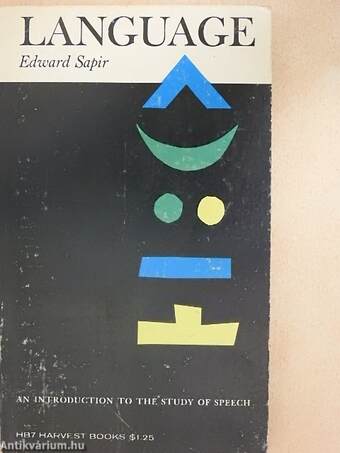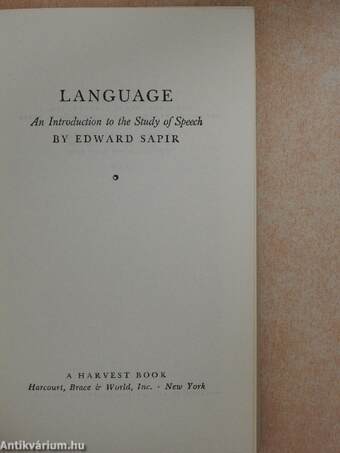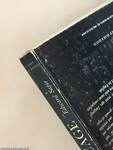1.067.672
kiadvánnyal nyújtjuk Magyarország legnagyobb antikvár könyv-kínálatát

VISSZA
A TETEJÉRE
JAVASLATOKÉszre-
vételek
Language
An Introduction to the Study of Speech
| Kiadó: | Harcourt, Brace & World, Inc. |
|---|---|
| Kiadás helye: | New York |
| Kiadás éve: | |
| Kötés típusa: | Ragasztott papírkötés |
| Oldalszám: | 242 oldal |
| Sorozatcím: | Harvest Book |
| Kötetszám: | |
| Nyelv: | Angol |
| Méret: | 18 cm x 11 cm |
| ISBN: | |
naponta értesítjük a beérkező friss
kiadványokról
naponta értesítjük a beérkező friss
kiadványokról
Fülszöveg
LANGUAGE
AN INTRODUCTION TO 1 HE S L UI)Y OF SPEECH
Language and culture, Sapir contends, are separate-frorn each other. Clontrary to conventional hel iel , ., language is not an expression of "national temper ament," or of racial or géographie influences, and is not an inheriteo skill.
Against this général background, Professor Sapii * analyzes, for student and commoh reader, the elements of language. Among these are the units of jU» language. {i.e% the word with its "radical" 'and "grammatical" parts) , grammatical. concepts and their origins, how languages differ and resemblc eafh otliei , and the history cSf the growth of repre sentative languages.
Written more thari tlfirty years ago, Language stands as one of the clearest and most coniprehen-sive surveys of its subject in English.
Tartalom
preface
I. Introductory: Language Defined %
Language a cultural, not a biologically inherited, function. Futility of interjectional and sound-imitative theories of the origin of speech. Définition of language. The psycho-physical basis of speech. Concepts and language. ís thought possible without language? Abbreviations and transfers of the speech process. The universality of language.
II. The Eléments of Speech 24
Sounds not properly elements of speech. Words and significant parts of words (radical elements, grammatical elements). Types of words. The word a formai, not a functional unit. The word has a real psychological existence. The sentence. The cognitive, volitional, and emotional aspects of speech. Feeling-tones of words.
III. The Sounds of Language 42
The vast number of possible sounds. The articulating organs and their share in the production of speech sounds: lungs, glottal cords, nose, mouth and its parts. Vowel articulations. How and where consonants are articulated. The phonetic habits of a language. The "values" of sounds. Phonetic patterns.
IV. Form in Language: Grammatical Processes 57
Formai processes as distinct from grammatical functions. Intercrossing of the two points of view. Six main types of grammatical process. Word sequence as a method. Com-pounding of radical elements. Affixing: préfixés and suffixes; infixes. Internai vocalic change; consonantal change. Reduplication. Functional variations of stress; of pitch.
Vili
LANGUAGE
V. Form ni Language: Grammatical Concepts 8s
Analysis of a typical English sentence. Types of concepts illustrated by it. Inconsistent expression of analogous concepts. How the same sentence may be expressed in other lan-guages with striking différences in the selection and grouping of concepts. Essential and non-essential concepts. The mixing of essential relational concepts with secondary ones of more concrete order. Form for form's sake. Classification of lin-guistic concepts: basic or concrete, derivational, concrete relational, pure relational. Tendency for these types of concepts to flow into each other. Catégories expressed in varions grammatical systems. Order and stress as relating principies in the sentence. Concord. Parts of speech: no absolute classification possible; noun and verb.
VI. Types of Linguistic Structure 120
The possibility of classifying languages. Difficulties. Classification into form-languages and formless languages not valid. Classification according to formai processes used not practicable. Classification according to degree of synthesis. "Inflec-tive" and "agglutinative." Fusion and symbolism as linguistic techniques. Agglutination. "Inflective" a confused term. Threefold classification suggested: what types of concepts are expressed? what is the prevailing technique? what is the degree of synthesis? Four fundamental conceptual types. Examples tabulated. Historical test of the validity of the suggested conceptual classification.
VII. Language as a Historical Product: Drift 147
Variability of language. Individual and dialectic variations. Time variation or "drift." How dialects arise. Linguistic stocks. Direction or "slope" of linguistic drift. Tendencies illustrated in an English sentence. Hésitations of usage as symptomatic of the direction of drift. Leveling tendencies in English. Weakening of case éléments. Tendency to fixed position in the sentence. Drift toward the invariable word.
VIII. Language as a Historical Product: Phonetic Law 171
Parallels in drift in related languages. Phonetic law as illustrated in the history of certain English and Germán vowels and consonants. Regularity of phonetic law. Shifting of sounds without destruction of phonetic pattern. Difficulty of explaining the nature of phonetic drifts. Vowel mutation in English and Germán. Morphological influence on phonetic change. Analogical levelings to offset irreguiarities produced
by phonetic laws. New morphological features due to pho-netic change.
IX. How Languages Influence Each Other 192
Linguistic influences due to cultural contact. Borrowing of words. Résistances to borrowing. Phonetic modification of borrowed words. Phonetic interinfluencings of neighboring languages. Morphological borrowings. Morphological resem-blances as vestiges of genetic relationship.
X. Language, Race and Culture 207
Naive tendency to consider linguistic, racial, and cultural groupings as congruent. Race and language need not correspond. Cultural and linguistic boundaries not identical. Coincidences between linguistic cleavages and those of language and culture due to historical, not intrinsic psychologi-cal, causes. Language does not in any deep sense "reflect" culture.
XI. Language and Literature 221
Language as the material or medium of literature. Literature may move on the generalized linguistic plane or may be inséparable from spécifié linguistic conditions. Language as a collective art. Necessary esthetic advantages or limitations in any language. Style as conditioned by inherent features of the language. Prosody as conditioned by the phonetic dy-namics of a language.
index
233-243









